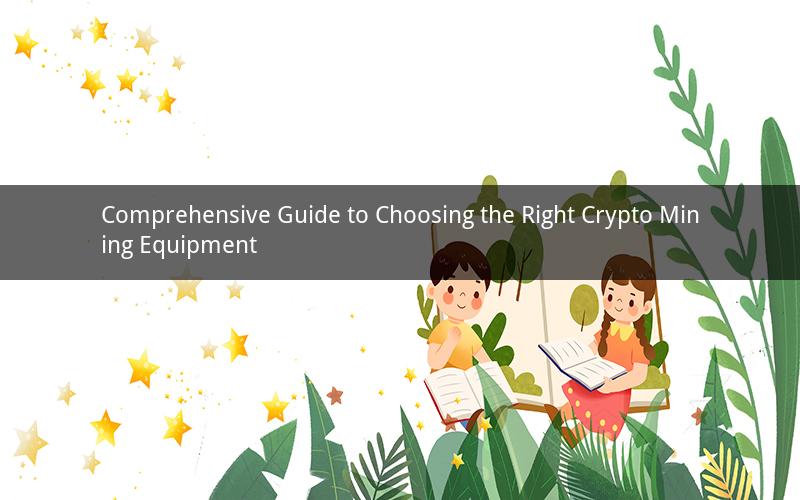
In the rapidly evolving world of cryptocurrency, mining has become an essential aspect for many investors and enthusiasts. With the increasing popularity of digital currencies, more individuals are interested in joining the mining community. However, many newcomers often wonder what equipment they need to start mining crypto. This article will provide a detailed guide on the essential hardware components required for successful crypto mining.
1. Mining Rig
The heart of your mining operation is the mining rig, which consists of multiple GPUs or CPUs connected to a power supply unit (PSU) and a motherboard. A high-performance rig can significantly impact your mining efficiency and profitability. Here are some factors to consider when selecting a mining rig:
- GPU/CPU: Choose a powerful GPU or CPU that offers the best hash rate and power efficiency. GPUs are more common in crypto mining due to their higher hash rates, while CPUs are suitable for smaller operations.
- Motherboard: A robust motherboard with multiple PCIe slots and adequate power connections is crucial for housing your GPUs or CPUs.
- PSU: Invest in a reliable PSU with sufficient power output and efficiency. Ensure the PSU is compatible with your rig's components and has multiple 6/8-pin PCIe connectors.
- Cooling: Adequate cooling is essential to prevent overheating and maintain optimal performance. Consider using air or liquid cooling systems.
2. Mining Software
Once your rig is assembled, you need mining software to connect it to a mining pool or solo mine. Here are some popular mining software options:
- CGMiner: An open-source mining software compatible with various devices, including GPUs, FPGAs, and ASICs.
- BFGMiner: A multi-threaded, multi-algorithm miner that supports a wide range of algorithms and devices.
- Claymore's Dual Ethereum: A highly efficient Ethereum miner optimized for NVIDIA GPUs.
- PhoenixMiner: A popular Ethereum miner known for its performance and ease of use.
3. Mining Pool
Joining a mining pool can increase your chances of earning rewards and provide stability in your earnings. Here are some factors to consider when choosing a mining pool:
- Pool size: Larger pools have a higher chance of generating blocks, but your share of the rewards may be smaller.
- Fees: Different pools charge varying fees for their services. Choose a pool with a reasonable fee structure.
- Payment methods: Ensure the mining pool supports payment methods that are convenient for you.
- Uptime: A mining pool with high uptime ensures consistent mining opportunities.
4. Electricity and Cooling
Electricity consumption is a significant factor in crypto mining profitability. Ensure your power costs do not outweigh your potential earnings. Here are some tips to minimize electricity usage:
- Choose an energy-efficient rig and components.
- Optimize your rig's settings for power efficiency.
- Monitor your rig's power consumption regularly.
Cooling is also crucial to prevent overheating and maintain your rig's lifespan. Consider the following:
- Use efficient cooling systems, such as air or liquid cooling.
- Maintain proper airflow within your mining room.
5. Maintenance and Upgrades
Regular maintenance is essential to keep your mining rig running smoothly. Here are some maintenance tips:
- Dust off your components regularly.
- Check for any signs of wear and tear on cables and connectors.
- Monitor your rig's performance and replace outdated components when necessary.
Upgrades can improve your mining rig's efficiency and profitability. Here are some potential upgrades:
- Replace your GPU or CPU with a more powerful model.
- Upgrade your PSU to a higher wattage and efficiency rating.
- Invest in a better cooling system.
Frequently Asked Questions
1. Q: How do I choose the right GPU for crypto mining?
A: Look for GPUs with high hash rates and power efficiency. NVIDIA and AMD GPUs are popular choices due to their performance and compatibility with various mining algorithms.
2. Q: What is the difference between a GPU and an ASIC?
A: GPUs are versatile and suitable for mining multiple cryptocurrencies, while ASICs are designed specifically for mining a single cryptocurrency, usually Bitcoin.
3. Q: How can I determine the profitability of my mining operation?
A: Use mining profitability calculators to estimate your potential earnings based on the hash rate, electricity cost, and current market prices of cryptocurrencies.
4. Q: Should I join a mining pool or solo mine?
A: Joining a mining pool provides stability and a higher chance of earning rewards, but solo mining can be more profitable if you have the resources to compete with larger pools.
5. Q: How can I improve the efficiency of my mining rig?
A: Optimize your rig's settings for power efficiency, invest in a better cooling system, and regularly maintain your components to ensure optimal performance.